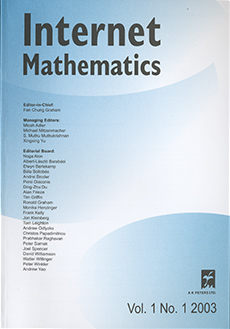Abstract
We study a strategic game in which every node of a graph is owned by a player who has to choose a color. A player’s payoff is 0 if at least one neighbor selected the same color; otherwise, it is the number of players who selected the same color. The social cost of a state is defined as the number of distinct colors that the players use. It is ideally equal to the chromatic number of the graph, but it can substantially deviate because every player cares about his own payoff, however bad the social cost may be. Following previous work in Panagopoulou and Spirakis, “A Game Theoretic Approach for Efficient Graph Coloring,” on the Nash equilibria of the coloring game, we give worst-case bounds on the social cost of stable states. Our main contribution is an improved (tight) bound for the worst-case social cost of a Nash equilibrium, as well as the study of strong equilibria, their existence, and how far they are from social optima.
Citation
Bruno Escoffier. Laurent Gourvès. Jérôme Monnot. "Strategic Coloring of a Graph." Internet Math. 8 (4) 424 - 455, 2012.
Information




